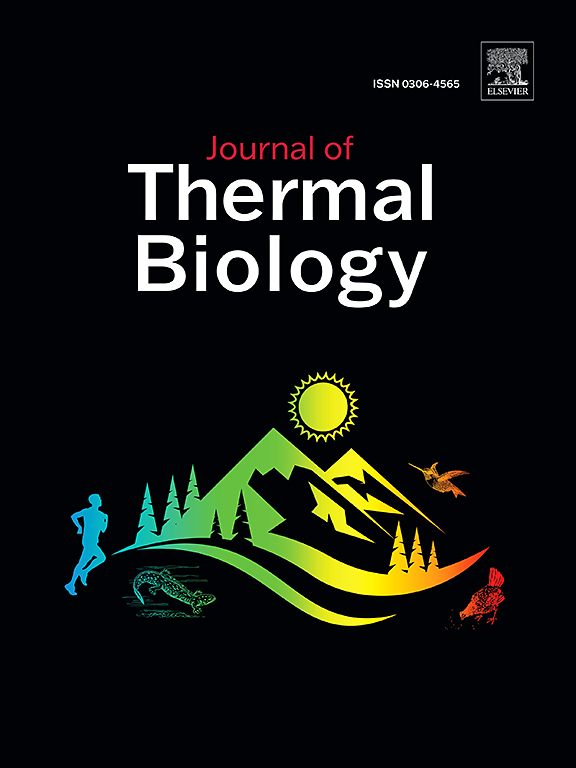男性人群中自行车运动热应激测试的可重复性
IF 2.9
2区 生物学
Q2 BIOLOGY
引用次数: 0
摘要
导言:个体间对环境压力的生理反应存在相当大的差异,因此要准确评估和监测个体应对运动热应激能力的变化,需要一个可靠的方案。本研究的目的是检测 90 分钟稳态热量运动与生理和主观变量的可重复性,以及 90 分钟稳态运动后进行增量测试以达到力竭时的表现。方法 16 名能力参差不齐的男性(年龄:39±15 岁;身高:176.5±4.8 厘米;体重:79.7±10.3 千克;V˙O2 峰值:46.2±8.6 毫升)在 90 分钟稳态热量运动后进行增量测试以达到力竭时的表现:46.2±8.6ml/kg/min;PPO:309±39W),每周至少训练三次,在湿热环境(35 °C,60%RH)中进行了两次为期 90 分钟的稳态骑行热应激测试(HST),随后进行了增量测试以达到力竭。全程测量心率(HR)、直肠温度(T‾re)和皮肤温度(T‾sk)、体力消耗等级(RPE)、热感觉(TS)和热舒适度(TC)。结果除 HR90、₸sk90 和 ₸sk 外,其他生理变量的可重复性较好,表现在 ICC 评级为中等至较高,变化幅度(d)较低,与各自计算的 TEM 相比平均偏差较小,且无统计学意义。除尿液渗透压(osmu90)和静止尿液颜色(colu)外,水合状态显示出良好的重复性。除静息 TS 和平均 TS 外,其他感知变量的重复性令人鼓舞。性能数据总体显示出良好的可重复性,但在第二次访问中,有 11 名参与者进行了力竭增量测试,而第一次访问中只有 7 名参与者。然而,鉴于更多参与者在第二次访问中进行了力竭递增试验,至少一次熟悉试验可能会提高运动能力评估的可靠性。本文章由计算机程序翻译,如有差异,请以英文原文为准。
The repeatability of a cycling exercise-heat stress test in a male population
Introduction
There is considerable inter-individual variability in the physiological responses to environmental stressors and so to accurately assess and monitor changes in an individual's ability to cope with exercise-heat stress, a reliable protocol is required. The aim of this study was to examine the repeatability of a 90-min steady-state heat exercise bout with physiological and subjective variables, and performance during an incremental test to exhaustion post 90-min steady-state exercise.
Method
Sixteen mixed ability males (Age: 39 ± 15yrs; Height: 176.5 ± 4.8 cm; BM: 79.7 ± 10.3 kg; O2peak: 46.2 ± 8.6 ml/kg/min; PPO: 309 ± 39W) who trained at least three times a week undertook two 90-min steady-state – followed by an incremental protocol to exhaustion – cycling heat stress tests (HSTs) in a hot-humid environment (35 °C, 60%RH). Heart rate (HR), rectal ( re) and skin temperature (sk), rating of perceived exertion (RPE), thermal sensation (TS), and thermal comfort (TC) were measured throughout. Data was analysed using Intraclass Correlation Coefficients (ICC), technical error of measurement (TEM), Bland-Altman plots, t-tests, and Cohen's d to indicate magnitude of change.
Results
Physiological variables indicated good repeatability evident through moderate to strong ICC ratings, low magnitudes of change (d), lower mean biases compared to their respective calculated TEMs, and statistical non-significance, except HR90, ₸sk90, and ₸sk. Hydration status showed good repeatability except for urine osmolality (osmu90) and resting urine colour (colu). Perceptual variables showed encouraging repeatability apart from resting TS and mean TS. Performance data showed good repeatability overall, however 11 participants progressed to the incremental test to exhaustion in the second visit compared to 7 in the first.
Conclusion
Current data demonstrated favourable physiological, perceptual, and performance repeatability during repeated cycling HSTs in hot-humid conditions. However, given more participants progressed to the incremental trial to exhaustion protocol in the second visit, at least one familiarisation trial may improve the reliability of exercise capacity assessment.
求助全文
通过发布文献求助,成功后即可免费获取论文全文。
去求助
来源期刊

Journal of thermal biology
生物-动物学
CiteScore
5.30
自引率
7.40%
发文量
196
审稿时长
14.5 weeks
期刊介绍:
The Journal of Thermal Biology publishes articles that advance our knowledge on the ways and mechanisms through which temperature affects man and animals. This includes studies of their responses to these effects and on the ecological consequences. Directly relevant to this theme are:
• The mechanisms of thermal limitation, heat and cold injury, and the resistance of organisms to extremes of temperature
• The mechanisms involved in acclimation, acclimatization and evolutionary adaptation to temperature
• Mechanisms underlying the patterns of hibernation, torpor, dormancy, aestivation and diapause
• Effects of temperature on reproduction and development, growth, ageing and life-span
• Studies on modelling heat transfer between organisms and their environment
• The contributions of temperature to effects of climate change on animal species and man
• Studies of conservation biology and physiology related to temperature
• Behavioural and physiological regulation of body temperature including its pathophysiology and fever
• Medical applications of hypo- and hyperthermia
Article types:
• Original articles
• Review articles
 求助内容:
求助内容: 应助结果提醒方式:
应助结果提醒方式:


